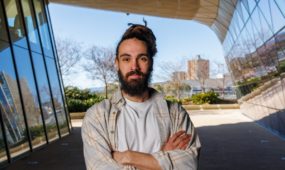Something to Bragg about
Health & Medical
The South Australian Health and Medical Research Institute will harness the power of protons to treat cancer at the new Australian Bragg Centre for Proton Therapy and Research.

Sign up to receive notifications about new stories in this category.
Thank you for subscribing to story notifications.

Animated superhero Roger Ramjet is renowned for taking a proton pill before stopping crooks in their tracks.
While science isn’t yet able to pack protons into a pill, protons can be applied for cancer treatment.
SAHMRI’s Dr Alexandre Santos is a medical physicist, and part of a team developing Australia’s first proton therapy centre at the Australian Bragg Centre for Proton Therapy and Research in Adelaide, South Australia.
“The Bragg Centre includes a synchrotron unit, which will accelerate protons to high energies for therapy,” says Alex.
“Right next door to SAHMRI, this will be the first clinically dedicated proton beam therapy centre in the southern hemisphere.”
Proton beam therapy is a type of radiotherapy that targets tumours with high-energy, positively charged particles. It can be delivered in such a precise way making it ideal for treating cancers without damaging surrounding healthy tissues – which often happens with traditional radiation therapy.
Alex says collateral damage from traditional radiation can be particularly worrisome when treating children.
“Radiation of healthy cells can lead to new cancers forming ten or twenty years down the line,” Alex explains.
“These late side effects are of particular concern for our young patients.”
Radiation therapy can have other devastating impacts on children too, something Associate Professor Jordan Hansford has witnessed as a clinician managing children with brain cancers. Jordan is head of the Paediatric Neuro-Oncology Program in SAHMRI’s Precision Cancer Medicine theme.
“Radiation damage while treating brain cancers can create problems with growth and hormone production and lead to neurocognitive problems including low IQ in children,” he says.
“With access to proton therapy at the new Bragg Centre, we hope to be able to limit the exposure of normal brain tissue to radiation, which will improve survival and lessen side effects for children with brain cancers.”
The Australian Bragg Centre for Proton Therapy and Research will occupy the ground floor and three below-ground levels of the Australian Bragg Centre building currently under construction on the eastern side of SAHMRI, which is part of a larger biomedical precinct on North Terrace in Adelaide called BioMed City.
Once the building is completed in 2023, the proton therapy machine will undergo 12-18 months of installation and testing before patient treatment begins. It will provide a local treatment option for children with cancers who currently have to travel overseas for treatment
Based at SAHMRI, the team leading the development of The Australian Bragg Centre for Proton Therapy and Research has grown from just two to 13 people in recent months – including Alex and Jordan, who joined in December 2021.
Alex says one of the things that struck him immediately was the strong sense of community in the building.
“It’s clear SAHMRI takes its position in the community very seriously,” Alex says.
“Here you feel like you’re part of a bigger team, and that you have a role to play.”
As an example, Alex says he was delighted to learn that within SAHMRI there are organised blood donation trips so staff can easily participate.
“Such a small and simple thing, but it’s great to see an organisation actually set up the framework to support blood donation.”
SAHMRI’s primary reason-for-being is to provide service to the community, as South Australia’s independent, not-for-profit health and medical research institute.
SAHMRI researchers work closely with each other and the world’s best medical experts to find better ways to treat, heal and care for people. They are funded by grants from state and national funding bodies and philanthropy.
Donations help elevate the search for discoveries in each of the four research themes: Precision Cancer Medicine, Women and Kids, Lifelong Health and Aboriginal Health Equity (Wardliparingga).
SAHMRI is also home to essential resources and infrastructure that service South Australia, including technology and tools to support research and produce diagnostics, registries to track health data and trends, and centres to translate research into policy and effective health responses, including for COVID-19.
Over the next few years, The Australian Bragg Centre for Proton Therapy and Research will begin to elevate the work SAHMRI already does to improve health in South Australians.
Jump to next article



